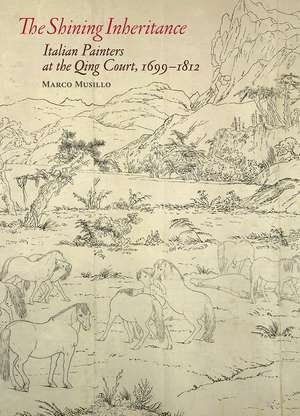The Shining Inheritance: Italian Painters at the Qing Court, 1699–1812
Autor Marco Musilloen Limba Engleză Hardback – 6 iun 2016
During Qing dynasty China, Italian artists were hired through Jesuit missionaries by the imperial workshops in Beijing. In The Shining Inheritance: Italian Painters at the Qing Court, 1699–1812, Marco Musillo considers the professional adaptations and pictorial modifications to Chinese traditions that allowed three of these Italian painters — Giovanni Gherardini (1655– ca. 1729), Giuseppe Castiglione (1688–1766), and Giuseppe Panzi (1734–1812) — to work within the Chinese cultural sphere from 1699, when Gherardini arrived in China, to 1812, the year of Panzi’s death. Musillo focuses especially on the long career and influence of Castiglione (whose Chinese name was Lang Shining), who worked in Beijing for more than fifty years. Serving three Qing emperors, he was actively engaged in the pictorial discussions at court.
The Shining Inheritance perceptively explores how each painter’s level of professional artistic training affected his understanding, selection, and translation of the Chinese pictorial traditions. Musillo further demonstrates how this East-West artistic exchange challenged the dogma of European universality through a professional dialogue that became part of established workshop routines. The cultural elements, procedures, and artistic languages of both China and Italy were strategically played against each other in negotiating the successes and failures of the Italian painters in Beijing. Musillo’s subtle analysis offers a compelling methodological model for an increasingly global field of art history.
The Shining Inheritance perceptively explores how each painter’s level of professional artistic training affected his understanding, selection, and translation of the Chinese pictorial traditions. Musillo further demonstrates how this East-West artistic exchange challenged the dogma of European universality through a professional dialogue that became part of established workshop routines. The cultural elements, procedures, and artistic languages of both China and Italy were strategically played against each other in negotiating the successes and failures of the Italian painters in Beijing. Musillo’s subtle analysis offers a compelling methodological model for an increasingly global field of art history.
Preț: 343.13 lei
Preț vechi: 392.11 lei
-12% Nou
Puncte Express: 515
Preț estimativ în valută:
65.67€ • 68.04$ • 54.80£
65.67€ • 68.04$ • 54.80£
Carte indisponibilă temporar
Doresc să fiu notificat când acest titlu va fi disponibil:
Se trimite...
Preluare comenzi: 021 569.72.76
Specificații
ISBN-13: 9781606064740
ISBN-10: 1606064746
Pagini: 192
Ilustrații: 33 color and 33 b-w illustrations
Dimensiuni: 191 x 267 x 20 mm
Greutate: 0.95 kg
Ediția:1
Editura: Getty Publications
Colecția Getty Research Institute
ISBN-10: 1606064746
Pagini: 192
Ilustrații: 33 color and 33 b-w illustrations
Dimensiuni: 191 x 267 x 20 mm
Greutate: 0.95 kg
Ediția:1
Editura: Getty Publications
Colecția Getty Research Institute
Recenzii
“Lavishly illustrated, and including an invaluable glossary and bibliography, this book is required reading for scholars and connoisseurs of Chinese and Italian art.”—Choice
Notă biografică
Marco Musillo is a research fellow at the Kunsthistorisches Institut in Florence.
